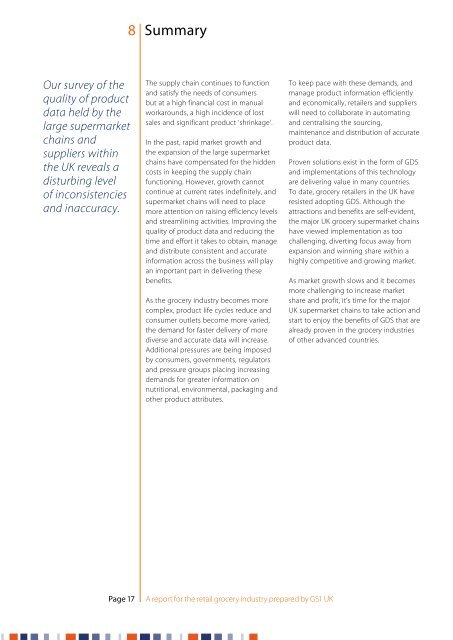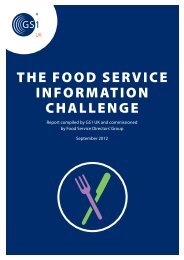You also want an ePaper? Increase the reach of your titles
YUMPU automatically turns print PDFs into web optimized ePapers that Google loves.
8 Summary<br />
Our survey of the<br />
quality of product<br />
data held by the<br />
large supermarket<br />
chains and<br />
suppliers within<br />
the <strong>UK</strong> reveals a<br />
disturbing level<br />
of inconsistencies<br />
and inaccuracy.<br />
The supply chain continues to function<br />
and satisfy the needs of consumers<br />
but at a high financial cost in manual<br />
workarounds, a high incidence of lost<br />
sales and significant product ‘shrinkage’.<br />
In the past, rapid market growth and<br />
the expansion of the large supermarket<br />
chains have compensated for the hidden<br />
costs in keeping the supply chain<br />
functioning. However, growth cannot<br />
continue at current rates indefinitely, and<br />
supermarket chains will need to place<br />
more attention on raising efficiency levels<br />
and streamlining activities. Improving the<br />
quality of product data and reducing the<br />
time and effort it takes to obtain, manage<br />
and distribute consistent and accurate<br />
information across the business will play<br />
an important part in delivering these<br />
benefits.<br />
As the grocery industry becomes more<br />
complex, product life cycles reduce and<br />
consumer outlets become more varied,<br />
the demand for faster delivery of more<br />
diverse and accurate data will increase.<br />
Additional pressures are being imposed<br />
by consumers, governments, regulators<br />
and pressure groups placing increasing<br />
demands for greater information on<br />
nutritional, environmental, packaging and<br />
other product attributes.<br />
To keep pace with these demands, and<br />
manage product information efficiently<br />
and economically, retailers and suppliers<br />
will need to collaborate in automating<br />
and centralising the sourcing,<br />
maintenance and distribution of accurate<br />
product data.<br />
Proven solutions exist in the form of GDS<br />
and implementations of this technology<br />
are delivering value in many countries.<br />
To date, grocery retailers in the <strong>UK</strong> have<br />
resisted adopting GDS. Although the<br />
attractions and benefits are self-evident,<br />
the major <strong>UK</strong> grocery supermarket chains<br />
have viewed implementation as too<br />
challenging, diverting focus away from<br />
expansion and winning share within a<br />
highly competitive and growing market.<br />
As market growth slows and it becomes<br />
more challenging to increase market<br />
share and profit, it’s time for the major<br />
<strong>UK</strong> supermarket chains to take action and<br />
start to enjoy the benefits of GDS that are<br />
already proven in the grocery industries<br />
of other advanced countries.<br />
Page 17<br />
A report for the retail grocery industry prepared by <strong>GS1</strong> <strong>UK</strong>
















